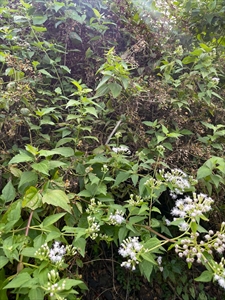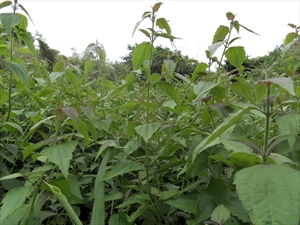- Worldwide. In Australia (Queensland, under eradication), Federated States of Micronesia, Guam, Marshall Islands, Northern Mariana Islands, Palau, Papua New Guinea.
- Major invasive weed: rapid growth, massive seed production, with economic and environmental impacts. Favours range of soils, forming dense tangled thickets overgrowing crop and forest plantations, pastures and native vegetation. Present also in neglected fields, wastelands, roadsides, riverbanks. Produces root chemicals inhibiting competitors (allelopathic).
- Multi-branched, 2.5m tall, round, yellowish stems, woody at base. Leaves, triangular, three-veined, serrated margins, in pairs on short stalks. Flowers, fluffy white to pale at end of stems. Seeds, narrow with white bristles. Swollen 'basal bulb' - storage organ.
- Spread: seeds on wind, water, hooked to clothing, animals, machinery. Forestry and pasture seed contaminant, in soil, sand and gravel.
- Biosecurity: among IUCN 100 World's Worst Invasive Species. National legislation needed to control introduction and release. Certify seed imports. In Australia, 'restricted invasive plant': do not release into environment, give away or sell.
- Biocontrol: moth (Pareuchaetes pseudoinsulata), and stem-galling fly (Cecidochares connexa) released.
- Cultural control: hand-weed, but do not slash or plough (root pieces regrow); plant competitive ground or tree legumes. Clean machinery/vehicles; check clothing; quarantine livestock 1 week between infested and ‘clean’ pastures.
- Chemical control: in Australia: picloram; fluroxypyr; glyphosate; triclopyr + picloram; triclopyr, picloram + aminopyralid; metsulfuron-methyl; fluroxypyr + aminopyralid.








